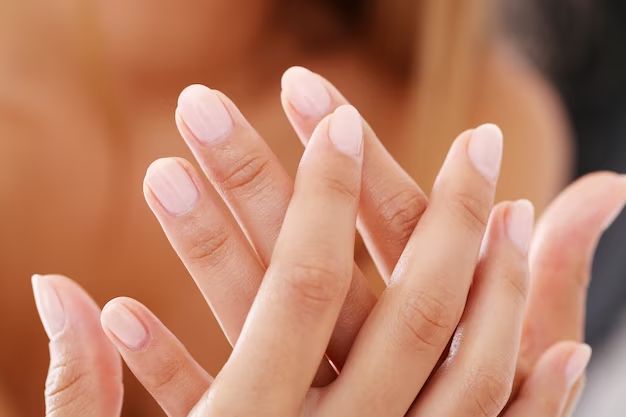The color of healthy nails can give an indication of the overall health of a person. While there is some normal variation in nail color, nails that are yellow, discolored, or otherwise abnormal in appearance may signal an underlying health issue. Generally speaking, healthy nails should be a pinkish color with a touch of whiteness near the tip. Tracking changes in nail color over time can help identify emerging health problems.
What Causes Nail Color Changes?
Nails get their pinkish hue from the network of tiny blood vessels under the nail bed. As blood circulates through these vessels, it impart a pink tint. Nails also have a translucent quality that allows the white color of the nail plate underneath to show through, especially near the tip. This gives healthy nails their characteristic pinkish-white coloration.
Changes in nail color can occur when something disrupts normal blood flow or causes a chemical change in the nail plate. Common causes of abnormal nail color include:
– Fungal infections – a fungal infection on the nail bed can cause thickening and yellow-brown discoloration.
– Bacterial infections – green nails may signal Pseudomonas bacterial infection.
– Trauma – blood trapped under the nail after an injury can make nails black and blue.
– Nail polish – residual pigment stained on the nail plate may cause yellowing.
– Chemical exposure – repeated exposure to certain chemicals may stain nails yellow or brown.
– Vitamin deficiencies – lack of key nutrients like biotin or zinc can affect nail growth.
– Systemic diseases – liver issues, lung problems, anemia, and diabetes can cause nail discoloration.
– Aging – nails may develop dark streaks or yellowing with age.
What Colors Signal a Health Problem?
While subtle changes in pinkness or whiteness are normal, certain nail colors like those listed below can be a sign of an underlying health issue:
Yellow nails
– Most commonly due to fungal infection or nail polish staining
– Can also signal respiratory conditions, diabetes, or thyroid issues
White nails
– May indicate liver problems, chronic kidney disease, or anemia
Blue nails
– Caused by thin nail beds allowing more visibility of blood vessels
– Associated with lung diseases or oxygen deficiency
Brown or black nails
– Fungal infection, melanoma, or blood under the nail (hematoma)
Green nails
– Bacterial infection, especially pseudomonas
Red nails
– Overactive thyroid (hyperthyroidism) or liver disease
Pale nails
– Anemia, malnutrition, or liver problems
Ridges or pitting
– Can signal psoriasis, inflammatory arthritis, eczema or alopecia areata
What is a Normal Pinkish Color for Healthy Nails?
There is some normal variation when it comes to the particular shade of pink considered healthy for nails. Some nails may be a light baby pink while others are a deeper rose color. Genetics, ethnicity, age, and sun exposure can all influence natural nail color. However, in most people with light to medium skin tones, healthy nails typically align with these characteristics:
– Pinkish-white near the tip of the nail
– A sheer, pinkish color over the nail bed area
– A smooth texture without ridges, pitting, or discoloration
– Subtle translucency allowing a hint of light to shine through
– No detached, thickened or distorted nails
– Consistent coloration across all ten fingers
Doctors may use an informal nail color chart to evaluate the shade of pink and look for deviations from normal:
| Nail Color | Meaning |
|---|---|
| Baby pink | Very healthy nails |
| Light pink | Normal healthy color |
| Whitish pink | May signal anemia |
| White | Can mean liver or kidney issues |
| Yellow | Fungal nail infection likely |
| Blue | Oxygen deprivation the cause |
| Green | Bacterial infection present |
| Brown or black | Melanoma or nail hematoma |
| Red | Overactive thyroid possible |
This chart shows how the shade of pink or any other color deviation may indicate a health issue that requires further evaluation.
Tips for Keeping Nails a Healthy Pink Color
While some nail color changes require medical treatment, you can help maintain healthy, pinkish nails by:
– Moisturizing nails daily with lotion
– Taking biotin and silica supplements for strength
– Avoiding excessive water exposure that can dry out nails
– Using gloves for cleaning, hair coloring, or other chemicals
– Alternating nail polish with periods of going bare
– Treating fungal infections early
– Monitoring nails for any new changes or deviations
– Seeing a doctor if color concerns arise
When to See a Doctor
Consult a healthcare provider if you notice any of the following about your nails so the cause can be properly diagnosed:
– Persistent yellow, brown, black discoloration
– Detached, thickened or distorted nails
– New Pitting, ridges, or grooves
– Redness, pain or swelling around the nails
– Bleeding from under the nails
– Severe brittleness or breakage
– Discoloration of some nails but not others
– Color concerns that don’t resolve with moisturizing
Conclusion
Healthy nails generally have a pinkish hue with touches of whiteness on the tips. This subtle coloration comes from the nail bed blood vessels and transparency of the nail plate. Any consistent yellow, brown or other color changes in a nail can signal a health problem like infection, trauma or systemic illness. While some variations in shade are normal, taking note of nail color changes helps spot potential issues. Keeping nails well-moisturized while avoiding too much water exposure or use of harsh chemicals helps maintain a natural pinkish nail color. Seeing a doctor promptly for nail discoloration, deformities or detachment allows quick treatment for the underlying cause. With vigilance and care, those healthy pink nails can stay pretty and problem-free.

